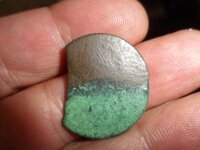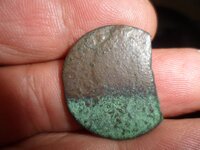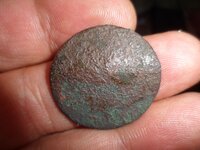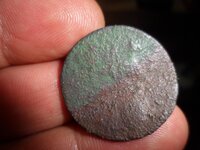flatbutton
Bronze Member
- Aug 21, 2013
- 1,460
- 1,131
- Detector(s) used
- Teknetics T2 SE, Tesoro Sand Shark,Nautilus DMC 1, Garrett Grand Master Hunter,Garrett Master Hunter 5 , Whites Coinmaster 5000/D
- Primary Interest:
- All Treasure Hunting
Follow along with the video below to see how to install our site as a web app on your home screen.
Note: This feature may not be available in some browsers.
Put a piece of aluminum foil in a glass dish (big enough to hold a cup of water) shiny side up, lay coin on foil, in a separate container bring to boil a cup of water, put in one tablespoon of salt and stir, put in one tablespoon of baking soda and stir. Be careful the water will fizz up when you add the baking soda. When salt and baking soda are dissolved in your boiled water, pour the hot mix into the glass dish with the foil and coin. Let the coin sit in the mix for 5 to 10 minutes, then remove coin and rinse it with warm water, dry it with a soft cloth. The soda/salt mix causes a electrolysis type reaction that in turn causes the tarnish (black stuff) to leave the coin and go to foil. Repeat the process as necessary. Pretty safe process of cleaning, leaves NO scratches, providing you don't rub too hard with the soft cloth when drying the coin. NOTE - The coin must be on the foil (touching/making contact), preferably laying flat on the foil!

Put a piece of aluminum foil in a glass dish (big enough to hold a cup of water) shiny side up, lay coin on foil, in a separate container bring to boil a cup of water, put in one tablespoon of salt and stir, put in one tablespoon of baking soda and stir. Be careful the water will fizz up when you add the baking soda. When salt and baking soda are dissolved in your boiled water, pour the hot mix into the glass dish with the foil and coin. Let the coin sit in the mix for 5 to 10 minutes, then remove coin and rinse it with warm water, dry it with a soft cloth. The soda/salt mix causes a electrolysis type reaction that in turn causes the tarnish (black stuff) to leave the coin and go to foil. Repeat the process as necessary. Pretty safe process of cleaning, leaves NO scratches, providing you don't rub too hard with the soft cloth when drying the coin. NOTE - The coin must be on the foil (touching/making contact), preferably laying flat on the foil!
I think that method may work...
I want sooooo bad to tell you about microwaving hydrogen peroxide. But I won't cause I'm know for inventive cleaning methods that absolutely destroy coins.
Oh, then there's my "tumbling" debacle!
I defer to all other recommendations.
GL
Peace ✌
I want sooooo bad to tell you about microwaving hydrogen peroxide. But I won't cause I'm know for inventive cleaning methods that absolutely destroy coins.
Oh, then there's my "tumbling" debacle!
I defer to all other recommendations.
GL
Peace ✌
Hydrogen perioxide only works on copper, brass or bronze based on what I see. Tumbling would probably ruin it though.

Never tried that method before Mike. Got a couple of slick Rosies that are spotted a little. Thinking about trying it out on those guys first.
I've used this method several times in the past, and had really good results. You mentioned trying it on a Rosie or two, go for it, I think you will be pleasantly surprised at the results. My sister in-in law turned me on to the method. Remember, if the tarnish is thick and/or very well adhered, you may have to repeat the process a time or two to get the desired result. Oh, I forgot to mention, I believe this method only works for silver. I first used the method to clean some silver jewelry. It worked so well, I then tried it on some coins, albeit no rare/valuable ones. Probably one of the safest methods of cleaning I have used, or heard of for that matter. Enjoy!
Also, be careful with some of this advice you are being given. The boiling peroxide, liquid plumber, and tumbling methods are NOT proper methods for your specific coin.

I hear you man! All I know for sure is Liquid Plummer IS DEF. not good for cleaning coins! I'll be a man and admit it, I dunked 2 colonial coppers in it and they instantly turned green. I can take pics of them to prove it, but I'm afraid you guys might throw up looking at them
Kind of curious to see how they looked. There are sometimes I regret cleaning finds...




